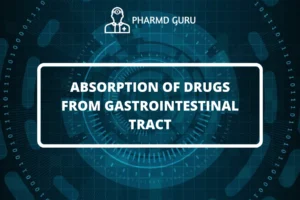Drug distribution refers to the movement of a drug throughout the body after it has been absorbed into the bloodstream. It involves various processes, including the transportation of drugs to different tissues and organs. Understanding drug distribution is essential for optimizing drug therapy and ensuring effective and targeted drug delivery. This article provides an introduction to drug distribution, the steps involved, factors influencing distribution, the concept of volume of distribution, protein binding of drugs, and factors affecting protein-drug binding.
SCROLL DOWN TO THE BOTTOM OF THE PAGE FOR ACTUAL NOTES
Steps in Drug Distribution
The process of drug distribution involves several steps:
- Bloodstream Transport: After absorption, drugs enter the bloodstream and are carried by the circulation throughout the body. They may bind to plasma proteins or circulate freely.
- Tissue Perfusion: As the blood flows through various tissues, drugs can diffuse across blood vessel walls and enter the interstitial fluid surrounding cells.
- Tissue Uptake: Drugs can then be taken up by cells within the tissues, either through passive diffusion or active transport processes.
- Binding to Intracellular Components: Within cells, drugs may bind to various intracellular components, such as enzymes or proteins.
- Metabolism and Elimination: In some cases, drugs may undergo metabolism within tissues, altering their chemical structure and potentially their pharmacological activity. Following distribution, drugs may also be eliminated from the body through processes such as renal excretion or hepatic metabolism.
Factors Affecting Distribution of Drugs
Several factors influence the distribution of drugs in the body:
- Blood Flow: The extent of blood flow to a particular tissue affects the delivery of drugs to that tissue. Highly perfused tissues, such as the liver, heart, and kidneys, receive a larger share of the drug dose compared to less perfused tissues.
- Tissue Composition: The composition of various tissues, including their lipid content and the presence of specific binding sites or transporters, can affect drug distribution. Lipophilic drugs tend to accumulate in adipose tissue, while hydrophilic drugs may distribute more evenly throughout the body.
- Drug Properties: The physicochemical properties of a drug, such as its molecular weight, size, and degree of ionization, can impact its distribution. Lipophilic drugs can readily cross cell membranes and distribute more widely, while larger or highly charged drugs may be restricted to certain tissues or compartments.
- Protein Binding: Many drugs can bind to plasma proteins, such as albumin. Protein-bound drugs are effectively inactive and do not readily distribute to tissues. Only the unbound, or free, fraction of a drug is available for distribution.
Volume of Distribution
The volume of distribution (Vd) is a pharmacokinetic parameter that reflects the theoretical volume in which a drug is distributed throughout the body. It provides insight into the extent of drug distribution beyond the bloodstream. Vd is calculated by dividing the amount of drug in the body by its plasma concentration.
A low Vd indicates limited distribution primarily within the bloodstream, while a high Vd suggests extensive distribution into tissues. The Vd value helps determine appropriate drug dosing and provides information about the drug’s distribution characteristics.
Protein Binding of Drugs and Factors Affecting Binding
Many drugs have an affinity for plasma proteins, particularly albumin. Protein binding affects the distribution, metabolism, and elimination of drugs. When drugs are bound to proteins, they are unable to exert their pharmacological effects and have limited ability to distribute to tissues.
Several factors can influence protein-drug binding:
- Competition for Binding Sites: Drugs that have similar binding sites on plasma proteins may compete for binding, leading to displacement of one drug by another. This can result in altered drug distribution and potentially increased drug activity.
- Changes in Protein Levels: Certain disease states or conditions can affect the levels or activity of plasma proteins, including albumin. Altered protein levels can impact drug binding and distribution.
- pH and Drug Ionization: The degree of ionization of a drug can affect its binding to proteins. Highly ionized drugs tend to have lower protein binding compared to non-ionized drugs.
- Genetic Variations: Genetic differences in plasma proteins or drug-metabolizing enzymes can influence drug-protein binding. This can lead to interindividual variability in drug response and distribution.
ACTUAL NOTES




